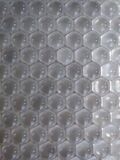Difference between revisions of "Lens array"
| Line 3: | Line 3: | ||
It is a flat piece of glass with tiny [[lenslet]]s manufactured into the surface. | It is a flat piece of glass with tiny [[lenslet]]s manufactured into the surface. | ||
| + | |||
| + | A microlens array can potentially be made out of a [[holographic optical element]]. | ||
They can be made out of [[fused silica]].<ref name="x003">{{cite web | title=Fused Silica Microlens Arrays | website=Thorlabs, Inc. | date=2014-08-11 | url=https://www.thorlabs.com/newgrouppage9.cfm?objectgroup_id=2861 | access-date=2024-05-11}}</ref> | They can be made out of [[fused silica]].<ref name="x003">{{cite web | title=Fused Silica Microlens Arrays | website=Thorlabs, Inc. | date=2014-08-11 | url=https://www.thorlabs.com/newgrouppage9.cfm?objectgroup_id=2861 | access-date=2024-05-11}}</ref> | ||
Revision as of 01:20, 19 July 2024
A microlens array is an optical device that has lots of tiny lenses. It can be used to make a light field display.
It is a flat piece of glass with tiny lenslets manufactured into the surface.
A microlens array can potentially be made out of a holographic optical element.
They can be made out of fused silica.[1]
A microlens array is used in Lytro's cameras.[2]
Each lens in the array has its own optical axis. However, when the array is viewed as a cohesive unit, the lenses form a shared main optical axis.[3]
Thorlabs advertises the sale of microlens arrays as of 2024.[1] Thorlabs has claimed that their lenslet arrays are formed using photolithographic techniques.[1]
The side with the roundings should generally face towards the source of the light. In a display, this means that the user's eye faces the flat side of the array, and the underlying display faces the side with the roundings.
Microlens arrays can be found in infra-red motion detectors.[4]
Manufacturing
Microlens arrays can be produced using microfabrication techniques, in particular photolithographic techniques.[5]
Microlens arrays have been manufactured at the wafer level by Lytro.[6]
Dimensions
Microlens arrays have been produced with a distance between microlenses of about 125 microns, which is 1/8 of a millimeter.[7][1]
To make a plenoptic microlens based display, each microlens should be at the minimum 200 pixels wide and 200 pixels long.
References
- ↑ Jump up to: 1.0 1.1 1.2 1.3 "Fused Silica Microlens Arrays". 2014-08-11. https://www.thorlabs.com/newgrouppage9.cfm?objectgroup_id=2861. Cite error: Invalid
<ref>tag; name "x003" defined multiple times with different content - ↑ "Lytro Specifications: A Deeper Look Inside". 2012-11-08. http://lightfield-forum.com/2012/11/lytro-specifications-a-deeper-look-inside/.
- ↑ "Microstructure Lens Arrays". 2024-06-21. https://www.laserfocusworld.com/directory/finished-optics-coatings-components/lens-arrays/product/14303094/avantier-inc-microstructure-lens-arrays.
- ↑ https://www.youtube.com/embed/HroJyGDoXI8?t=23
- ↑ https://patentimages.storage.googleapis.com/ae/55/08/039fdcbd181cb7/US20130033636A1.pdf
- ↑ "Karafin Lytro". 2024-03-06. https://www.youtube.com/watch?v=6nYXVT0QUkc.
- ↑ "Plenoptic Cameras: The Future of Imaging". 2024-03-06. https://www.youtube.com/watch?v=nyRgcD4VxE8.
